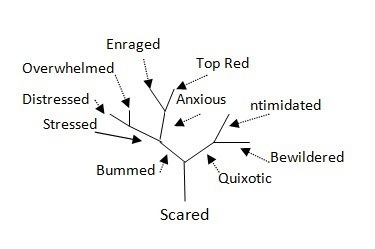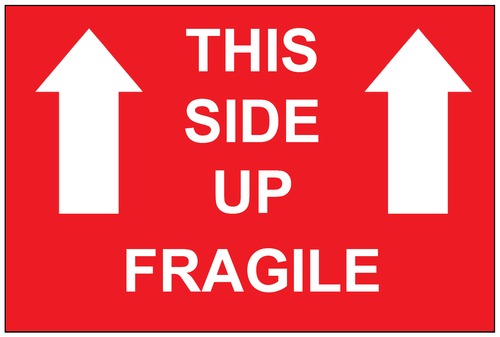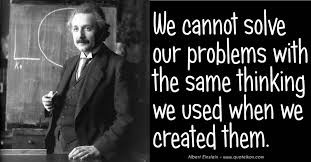Making sense of patterns.
From philosophy to fMRI’s humans have been trying to understand what role emotions play in our lives. The arts have been a source of expression and communication of our emotions. A myriad of strategies have been developed in order to help us keep our emotions in balance and a myriad of treatments exist to help us when our emotions get out of control.
In his buzz, Fractal Emotions and Perceptions, @Ali Anani has offered us the opportunity to “see a glimpse” of what happens when we experience an emotion. His work has inspired me to create the following exercises to be used both personally and professionally to get a clearer picture of what our emotions are communicating. Dr. Ali states:
"Our emotions are fractal and they change their trajectories depending on our starting emotion.”
To illustrate this he offers the following example.

As a result, we can see for ourselves now, by writing down the starting emotion and then by producing the branching out pattern, the cause and effect of what we are experiencing.
Exercise:
1. Think of a particular event, encounter or memory, and choose the first emotion that comes to mind. Write this emotion down as the starting emotion.
2. Now, go ahead and create the branching pattern. (Use the above as a model.)
3. Now let your eye fall on one of the branches and use that emotion as the starting emotion of the next branching pattern.
4. Repeat this step so you end up with 5 diagrams.
5. Place the 5 diagrams side by side and look for similarities and then differences.
For example: If the emotion “fearful” appears in each diagram, is it always in the same position or in different positions?
· When is it closest to the starting emotion? When is it furthest?
· Ask yourself, which emotion appears only once?
· Look at the 5 starting emotions, do you see how these emotions produce or reproduce a branching pattern?
· Ask yourself how your answers and observations relate to the original event, encounter or memory you used for the first diagram.
A variation on this exercise.
Think of a different event, encounter or memory for each individual diagram, for a total of 5 diagrams, and then look for the same things you did in the above exercise.
This exercise can be done in a work situation with a team focusing on problem solving.
1. Have the team articulate in one sentence what the problem is. On a white board, write out the problem statement.
2. While someone reads the problem statement, each member thinks of the first emotion that comes to mind when hearing the problem statement being read. Each member will now use that emotion as the starting emotion.
3. After everyone has completed their individual branching out diagram, a group diagram will be created.
4. On a white board, write the starting emotion of the majority of the members of the team (even if it’s just 2 the same) and then branch off doing the same thing; always writing down the common emotion for each branch.
The result is a team branching pattern.
For example: If the starting emotion is “stuck” and then the next emotions include “helpless”, “failure”, “frustrated” and so on, you will have a clear picture of the emotional pattern state of the team.
5. You then return to the problem statement and pair off the words in the statement with the emotions.
For example: If the word productivity appears in the problem statement and it is paired off with the starting emotion “stuck”, a discussion of the team's history of productivity up to the current situation can take place and an assessment can be made of the point when the flow of productivity became blocked and what could that blockage be.
Remember: The most important part of this process is to look at the patterns that the emotions have created.
Articles from Sara Jacobovici
View blog
ONE HUNDRED DAY COUNTDOWN · New beginnings take place constantly. When you thread them together, you ...

Image credit: French Stack Exchange · INTRODUCTION · It is my job to help individuals “make sense” o ...

Even when you say, "The sky's the limit.", you have set a boundary. That's not necessarily a bad thi ...
You may be interested in these jobs
-
CDMO Business Intelligence
Found in: beBee S2 IL - 3 days ago
Teva Pharmaceuticals Tel Aviv, IsraelWho we are · TAPI is the leading international supplier of active pharmaceutical ingredients (APIs). With the industry's broadest portfolio including over 350 API products, TAPI is the go-to global supplier for APIs, supporting 75% of the top 50 global pharmaceutical companies. H ...
-

DevOps Student
Found in: beBee S2 IL - 1 day ago
Nvidia Raanana, Israel Paid WorkNVIDIA is searching for a Software Development student which will join as a junior DevOps to our NVIDIA NMX team that is building a next gen Network management and Telemetry system in cloud and on-prem using modern design principles at internet scale. NVIDIA NMX is a highly scala ...
-
מתכנן קווי חלוקה
Found in: beBee S2 IL - 1 day ago
Teva Pharmaceuticals Shoham, Israelמי אנחנו / مين احنا · יחד, אנחנו שותפים למשימה להפוך את בריאות טובה לברת-מימון ונגישה יותר, כדי לעזור למיליוני אנשים ברחבי העולם ליהנות מחיים בריאים יותר. זו המשימה שמאחדת את האנשים שלנו בכ-60 מדינות, על פני מוצאים ורקע עשירים ומגוונים. · המשמעות של עבודה כאן היא עבודה עבור יצרני ...


Comments
Sara Jacobovici
7 years ago #6
Thank you @Praveen Raj Gullepalli. Your response is encouraging.
Sara Jacobovici
7 years ago #5
Enjoyed this as well John Vaughan, plus am getting ready to read up on the metaphors.
Sara Jacobovici
7 years ago #4
Dear John Vaughan, what a wonderful share and connection! I have never seen anything like it. Enjoyed it very much. Thank you.
Sara Jacobovici
7 years ago #3
Thanks for your contribution to the discussion Deb Lange.
Sara Jacobovici
7 years ago #2
I am at a loss for words Mohammed Sultan. You give me much encouragement. Thank you. In response to your question regarding which route to follow (I hope I don't disappoint you with my response), my first route would be with creating an environment in which the workers, supervisors and managers are reconnected to the product. From my experience, I have witnessed a detachment on the part of the workers from the product and an added detachment by the supervisors and managers not only from the product of the company but from the workers themselves.On the level of the directors, there is an additional detachment from the original vision or mission statement of the company. So, reconnecting and attaching would be the way to go.
Sara Jacobovici
7 years ago #1
Your response is very encouraging Ali Anani Thank you! I will follow this up with a real example.